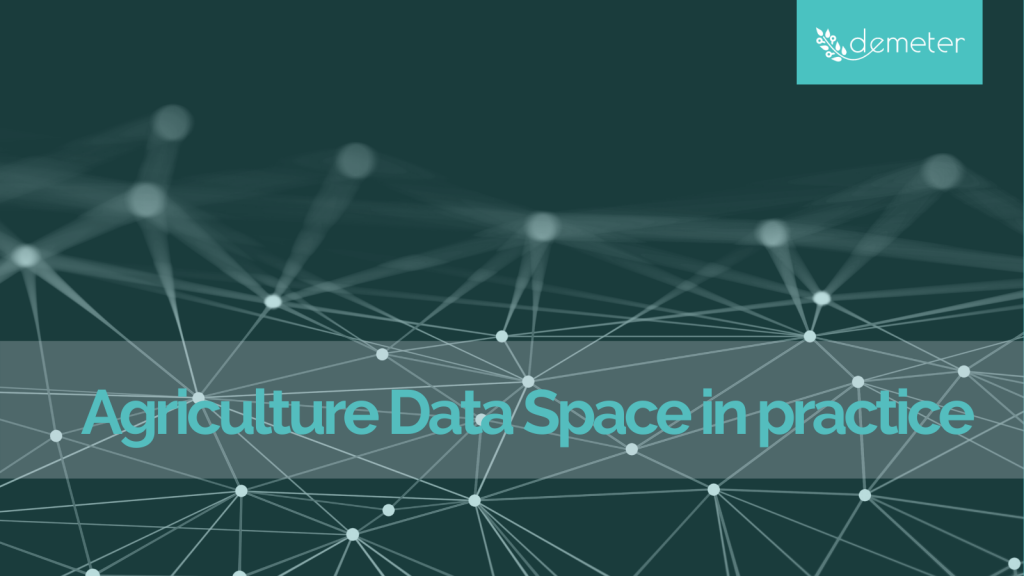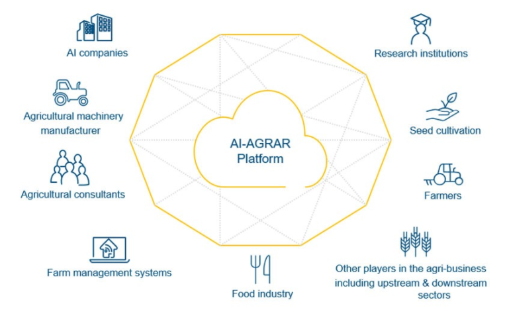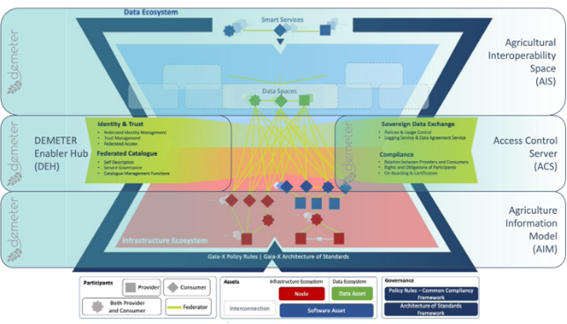
In this article, our project partner, Engineering, discuss how to deploy a real-world Agriculture Data Space in practice.
- Overview of the European context
Data-driven innovation plays a key role in the current transformation of our society and organizations, starting with data coming from users involved in the use of social networking tools, web and mobile apps, wearables devices and other internet-based applications. The ambition of the latest EU Data Strategy is connected to the idea of exploiting the next wave of data-driven innovation coming from business and industrial data. To this end the Commission has proposed a Regulation on European data governance as part of its data strategy which will play a vital role in ensuring the EU’s leadership in the global data economy. The Regulation will empower users to stay in control of their data with both the data strategy and the regulation on EU data governance encouraging the creation of common European Data Spaces in crucial sectors (such as health, environment, energy, agriculture, mobility, finance, manufacturing, public administration, and skills). Data Spaces can be seen as interconnected digital ecosystems that are able to guarantee an increasing availability of data, providing safe and reliable access and sharing, through digital platforms with clear and shared standards and governance. In such a vision, the Common European Data Spaces will ensure that more data becomes available for use in the economy and society, while keeping the companies and individuals who generate the data in control.
Several initiatives are promoting the adoption of data-driven digital transformation methodologies and tools, but the request for convergence is huge. Following this emerging need, the OPEN DEI project has recently conducted a Task Force (led by IDSA) with more than 40 experts, coming from different organizations, countries and backgrounds, active in the four sectors targeted by this CSA (Coordination and Support Action), namely manufacturing, agrifood, energy and health. This endeavour has resulted in a position paper named “Design Principles for Data Spaces”, containing the soft architecture, lessons learnt and a first collection of early data spaces coming from each of the four domains. The document represents the most acknowledged approach to date to define the essential elements that a generic Data Space (meaning addressable to every sector) has to include to concretely effect data economy empowerment, including agreements on the essential building blocks for a soft infrastructure and governance.
At the same time, the Gaia-X initiative was launched in 2020 to deliver technical solutions and a common standard of sovereign digital infrastructures to be adopted from a multitude of individual platforms and applications with a decentralized approach, at the same time safeguarding the main values of European Data Strategy meaning openness, transparency and trust.
The most recent convergence effort was established in September 2021, when a new collaboration called Data Spaces Business Alliance (DSBA) was announced as the first initiative of its kind, bringing together the necessary industry players to realise a data-driven future in which organizations and individuals can unlock the full value of their data, thanks to the value of having over 1,000 members combined among the Alliance’s founding organisations. In the DSBA vision, Data Spaces are viewed as key for achieving sovereign, interoperable and trustworthy data-sharing across businesses and societies – a key step to the data economy of the future.
2. Main characteristics of an Agriculture Data Space
Being a relatively new discipline, several initiatives have been addressing the interpretation and design of valuable Data Spaces with specific focus on Agriculture (in terms of main characteristics, quality, components, needs and issues as well as ideas and suggestions for their sustainability) and with the scope of identifying the current situation and the specific challenges. Most of them agree on the following major challenges for establishing an effective Agriculture Data Space:
- The nature of agricultural data is very specific and diverse: The agricultural data are very diverse (e.g. livestock and fish stock data, land and agronomic data, climate data, machine data, financial data, compliance data etc.); moreover considering the overall supply chain, it is necessary to add data such as food origin, quality, and safety information, including nutritional information, mix with aspects related to other sectors such as manufacturing, energy, logistics, and waste management [1].
Data Space contribution: Specific data modelling standards and semantics could help data collection, sharing and comparison for the specific sector.
- Trustful environment: The asymmetry of size between the players in the agrifood sector requires building a climate of trust between the business operators and the farmers. This means putting farmers in control of their data (enforcement of data sovereignty for the farmer as data originator) and, at the same time, promoting the benefits of sharing data and enabling agri-business models [1] [2] [3].
Data Space contribution: Creating a trustworthy environment can enhance the data sharing and exchange especially if the specific benefit for every actor involved is clear and tangible. Sovereign data services can ensure the identity of source and receiver of data and the access and usage rights towards the data. These services integrate the recommendations from the EU Code of Conduct on agricultural data sharing by contractual agreement to empower farmers on their own data governance.
- Data Interoperability and portability: there is low interoperability and portability between the different data driven tools and platforms developed in the agrifood ecosystem, so the farmer has to use many different platforms on a daily basis [1].
Data Space contribution: Semantic description of data formats can provide the necessary basic infrastructure to enable decentralized and interoperable data management in agriculture.
- Access to the digital single market: There is a need for a single market of available technologies/services/data sources to allow SMEs with novel applications to reach a good number of farmers and support farms to select the most suitable technology solution [3].
Data Space contribution: Reducing the fragmentation of the internal markets and enhance the EU competition by giving SMEs and start-ups the same opportunities to make the most of big data to grow in digital world.
- Need for sustainable business models: the business models behind the implementation of European agrifood Data Spaces require synergies and still need to be clarified. When connecting data sharing platforms in a federation, new federated business models are necessary [3].
Data Space contribution: Putting the data owners in control of their data can affect their level of independency from IT providers. Sustainable business models can incentivize data sharing and re–use through methods to estimate the value of data shared, non-financial incentive mechanisms, business models for intermediation services, quality assessment methods, agreement mechanisms (i.e. Smart contracts for value sharing).
- Data quality: Data quality is a common concern in a wide range of domains. In the agriculture sector, data quality is fundamentally important for the sector (as well as having the right data available at the right moment), indeed it is crucial that the data be useful and with a proper level of quality for the decision-making process and the planning activities [1].
Data Space contribution: Before data is fed into downstream analytics and decision support tasks it must be ensured that it meets general quality criteria. Data quality assessment of structured data and linked data need to be addressed to assure a full exploitation.
- Involving the whole chain from farm to fork: To fully deploy the possibilities of data sharing, it is important to connect the farm world with the rest of the food system, taking into consideration technical, legal, ethical, socio economical and business aspects [3].
Data Space contribution: Simplifying the exchange of sector-specific data through cross-sector collaboration and innovation.
The objective is to move towards a common European Agriculture Data Space, that is capable of addressing all the aforementioned challenges. As defined from Gaia-X approach, the Common European Agriculture Data Space, cannot be established from scratch but will combine existing data platforms and data sets, as a distributed system comprising different data platforms. It will consist in a key federation of existing IT infrastructures including platforms that deliver data sharing services known as data intermediaries. It is through these data intermediaries that a network can be formed to increase interoperability [3] (Gaia-X_DSBC_Position Paper)
As already mentioned, in this direction, both the federated architectures of International Data Spaces (IDS) and the more recently established Gaia-X architecture have been designed to accommodate a broad range of already existing legacy systems and platforms. In particular, Agri-Gaia (part of Gaia-X) represents a decentralised infrastructure for the exchange of data and algorithms in agriculture with the ambition to build an AI ecosystem for the SME agricultural and food industry based on Gaia-X offering domain-specific technologies, such as cross-industry identity management and semantic description of data formats (providing the necessary basic infrastructure to enable decentralized and interoperable data management in agriculture). Very importantly, through Gaia-X based standardization, Agri-Gaia enables farmers to move their data freely between different cloud platforms and use them economically themselves.

Figure 1 Agri-Gaia Platform
3. DEMETER: how to deploy a real-world Agriculture Data Space in practice
Starting from the afore-mentioned overview of acknowledged works made at EU level to identify the main challenges to be addressed into an Agriculture Data Space, this section aims to identify complementarities between the mentioned Data Space key elements/challenges and DEMETER as a potential validation ecosystem to reach a concrete empowerment toward deployment of Agriculture Data Space (in terms of datasets available, piloting activities, actors, technologies employed, …).
The DEMETER interoperability framework is in line with the above mentioned cross-domain approaches (e.g., IDSA and Gaia-X), being based on a Provider/Consumer approach following the same pattern as the Gaia-X/IDS architecture; therefore, it is, in principle, compliant with this approach – with additional extensions.
In particular, to facilitate the federation of existing systems, platforms and data sources coming from the project’s pilots, DEMETER defines a set of digital enablers, covering interoperability at the level of existing data, platforms, services, applications. To achieve this vision, DEMETER provides four indispensable contributions (among many others) to the farmers and the rest of stakeholders, suitable to address the aforementioned challenges related to the Agriculture Data Space:
- The design and implementation of the DEMETER Reference Architecture (RA) allow applications (part of DEMETER ecosystem) to exchange data and information coming from different sensors, and existing platforms, allowing the collection, processing and usage of the scattered data from the 20 large scale real pilots and providing an integrated view over different and heterogeneous datasets that can support the discovery and extraction of new knowledge.
- The design and delivery of the DEMETER Agriculture Information Model (AIM) that specifies a common vocabulary and underlying semantics, enabling different systems to exchange data. AIM constitutes the basis to enable the semantic interoperability between different systems and data models. This allows the semantic mapping of those ontologies and systems to AIM, which is a key factor for semantic interoperability that in turn enables collaboration and federation of FMSs and existing platforms.
- The design and implementation of the DEMETER User Registry or ACS (Access Control Server) User Repository, which supports GDPR compliant storing and securing users’ personal data, credentials, user permissions and other aspects of personal data.
- The design and the implementation of the DEH (DEMETER Enabler Hub) which represents the DEMETER Resource Repository, where a DEMETER stakeholder can discover all the resources offered by the data providers who will take part in the project. The DEH technology is suitable for future integrations outside DEMETER with other technologies in the agri-space. The internalization of resources from other platforms such as GAIA-X could be well supported, and also the exposure to the DEMETER resources data consumption is made possible, as long as third-party applications/services are compliant with the guidelines and the security protocols implemented in DEMETER via the ACS module.
The DEMETER Reference Architecture, the AIM and all the rest of DEMETER Enablers, through which the project aims to lead the Digital Transformation of the European agrifood sector, are validated and then updated based on the experience of 20 pilots around EU. Being a Large-Scale Pilot project, DEMETER facilitates the use of nearly any type of data source included in DEMETER-enabled apps, taking into account different types of agri-business issues in several contexts and countries and allows testing of the framework in real-life situations.
The below image shows the combined Gaia-X/IDS reference architecture extended with the corresponding DEMETER elements for the DEMETER Interoperability Space and the DEMETER Agriculture Data Space with the supporting elements of Federated Identity (ACS), Federated Catalogue (DEH) – and supporting Agricultural Vocabulary and AIM as common data model. The interaction of Gaia- X and IDS has three main tasks: self-sovereign data storage, trustworthy data usage and interoperable data exchange. DEMETER high-level and functional views can include all the sources of agri-data and can make them interoperable through the AIM.

Figure 2 DEMETER reference instantiation of the Gaia-X Architecture
4.Conclusion and Next Steps
Fostering interoperability solutions among a plethora of multiple individual platforms and solutions, DEMETER can be seen as a data/service intermediary and a suitable real-world testbed for an Agriculture Data Space, providing concrete solutions on governance models, operational architecture, and trustworthy data-driven innovations and, at the same time, resolving issues like data interoperability and data governance. Another key DEMETER achievement in this field is to contribute to the challenge that deals with incentivizing actors to share their data as part of this commitment to contribute to the design of a valuable Agriculture Data Space, we consider the monitoring of embryonic initiatives in the agrifood sector (such as API-AGRO, DjustConnect, JoinData, DKE-agrirouter) must be a priority.
Bibliography
«OPEN DEI. Design principles for data spaces. Position paper.,» [Online]. Available: https://design-principles-for-data-spaces.org/.
«Gaia-X- Data Space Business Committee – Position Paper,» [Online]. Available: https://www.gaia-x.eu/sites/default/files/2021-08/Gaia-X_DSBC_PositionPaper.pdf.
«Create-IoT – Data sharing in agriculture. Towards a European agriculture data space. Online workshop,» [Online]. Available: https://aioti.eu/wp-content/uploads/2020/07/Report_Data_Sharing_in_Agriculture_Online_Webinar_10.06.2020_Final.pdf.


